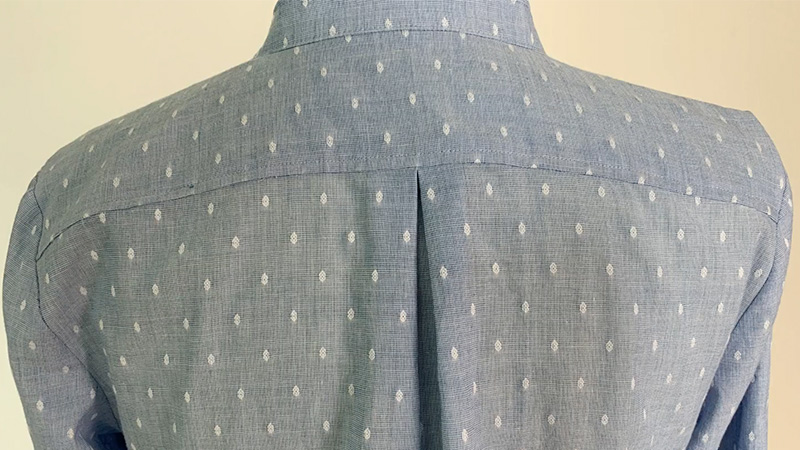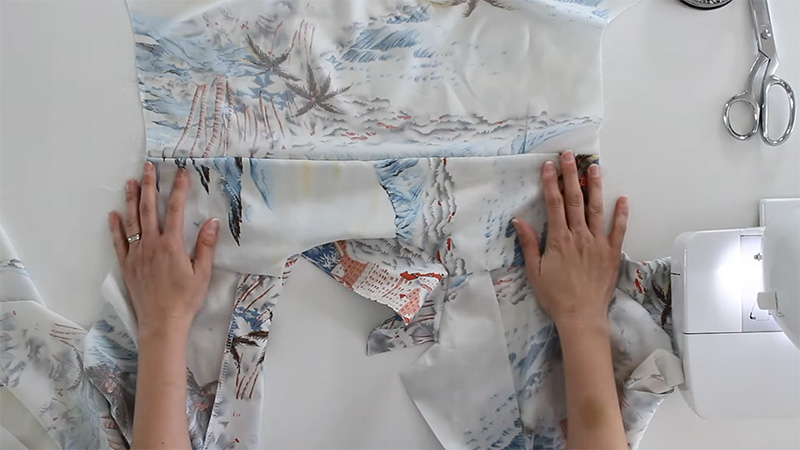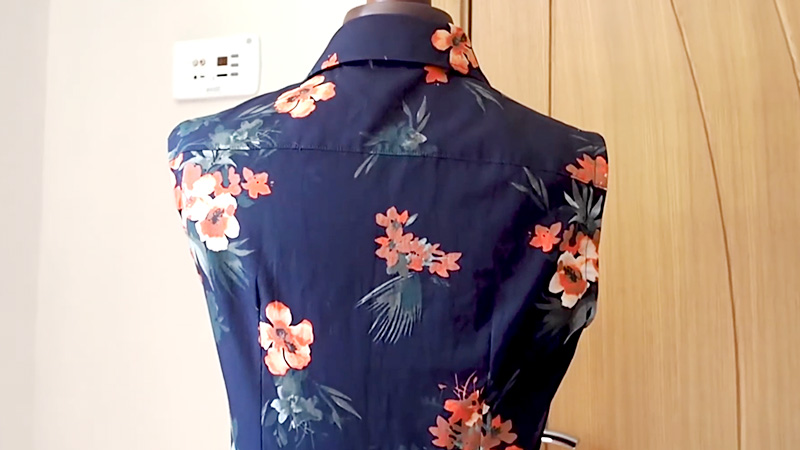The back yoke of a shirt is more than just a structural element; it’s a cornerstone of fit and style. This crucial fabric spans the upper back, providing stability and influencing how the shirt drapes.
Achieving a flawless back yoke requires careful attention to detail, from fabric selection to stitching techniques.
In this guide, we’ll delve into easy yet invaluable tips to ensure your back yoke is well-constructed and adds professionalism to your handmade shirts.
Whether you’re a seasoned tailor or a DIY enthusiast, these insights will empower you to perfect this essential component of shirt-making.

Understanding the Back Yoke
The back yoke of a shirt is a structural element that plays a crucial role in garment construction. Positioned across the upper back, it provides stability, enhances fit, and contributes to the overall aesthetic.
Often cut on the bias for flexibility, it connects the front and back panels, allowing for ease of shoulder movement.
This fabric is strategically placed to accommodate the body’s natural curve. Reinforcement with interfacing may be used to add durability and maintain shape.
Careful stitching, precise notching, and strategic trimming are essential for a clean, professional finish. Additionally, topstitching along the yoke seam adds strength and a tailored look. Understanding the back yoke is fundamental for creating well-constructed, comfortable shirts.
Back Yoke of a Shirt: Easy Tips to Make It Perfect

The back yoke of a shirt is a critical element in shirt construction, as it not only provides structural integrity but also contributes to the overall fit and style of the garment.
Whether you’re a seasoned tailor or a DIY enthusiast, here are some easy tips to help you create a perfect back yoke for your shirts:
Tools You’ll Need:
- Fabric Scissors.
- Pattern Pieces.
- Sewing Machine.
- Thread.
- Pins or Clips.
- Seam Ripper.
- Iron and Ironing Board.
- Pressing Cloth.
- Measuring Tape or Ruler.
- Notcher or Marking Tool.
- Tailor’s Chalk or Fabric Marker.
Fabric Selection
When choosing the fabric, consider its weight, drape, pattern, and texture. Lightweight cotton might be perfect for a casual shirt, while a sturdier fabric like denim could work well for a more structured or workwear-inspired piece.
Additionally, think about the color and pattern of the fabric for the rest of the shirt. The yoke fabric should harmonize with the overall design.
Pattern Placement
While cutting the fabric, align the pattern, especially if it’s a plaid, stripe, or repeating pattern. Ensure that the yoke’s grainline follows the fabric’s natural drape.
Cutting on the bias or a slight diagonal can give the yoke a bit of stretch, allowing for greater ease of movement. This is particularly important for shirts that must accommodate a wide range of motion.
Seam Allowance
Consider the purpose and style of the shirt when determining seam allowance. A slightly larger seam allowance might work well for a casual, relaxed fit, while a more tailored or formal shirt might benefit from a narrower allowance.
Whatever you choose, consistency is critical. A uniform seam allowance ensures even stitching and a polished finish.
Reinforcement
Interfacing can be a game-changer when it comes to reinforcing the yoke. Choose an interfacing that complements the fabric and provides the desired level of structure.
For a crisp, formal look, opt for a firm interface. Lighter, fusible interfacing can be used for a softer, more casual feel.
Fitting
Before attaching the yoke, double-check the alignment of the shoulder seams. This is a critical point for the overall fit of the shirt.
It’s worth taking some extra time here to ensure the seams are perfectly matched. Any misalignment can lead to discomfort and an unbalanced appearance.
Notching
Notches are like puzzle pieces that ensure everything lines up correctly during assembly. They are especially crucial when working with complex patterns or curved seams. Take the time to transfer these notches accurately from the pattern pieces to the fabric.
Sewing Technique
Pay close attention to your stitching technique. Ensure you’re using the correct stitch length for your fabric, and maintain a steady, even pace. Take care at the beginning and end of the seam to backstitch securely, providing additional strength to the seam.
Trimming and Clipping
Precision in trimming and clipping can make a significant difference in the final appearance of the yoke. Take care not to trim too close to the stitching to avoid compromising the strength of the seam.
Similarly, make strategic, shallow clips along curved edges to make the fabric flat without puckering.
Pressing
Pressing is an often underestimated step in garment construction. Use a quality iron and a pressing cloth to ensure that the seam allowances lie flat and that the yoke has a clean, professional finish. This step can make a massive difference in the overall appearance of the garment.
Topstitching
Consider the purpose of the topstitching. If it’s for reinforcement, opt for a thread that matches the fabric. However, if it’s meant to be a decorative element, don’t be afraid to experiment with contrasting colors or even decorative stitches.
Final Inspection
Before moving on to the next step, thoroughly inspect the yoke. Check for any loose threads or uneven stitching. Address any issues now to avoid making corrections later in the process.
Test Fit
Don’t skip the test fit! This step can catch any fit issues before you move on to attaching the sleeves or collar. It’s the last chance to make adjustments to ensure a comfortable, well-fitting garment.
Importance of Making a Back Yoke of the Shirt

The back yoke of a shirt serves several crucial functions, making it an integral part of the garment’s construction and fit.
Here are the key reasons why the back yoke is essential:
Structural Integrity
The back yoke provides essential structural support to the shirt. It reinforces the shoulders and upper back area, ensuring the garment maintains its shape and durability, especially during movements.
Shoulder Fit
A well-designed back yoke contributes to the proper fit of the shirt across the shoulders. It helps distribute tension evenly, preventing tightness or restriction of movement in this critical area.
Ease of Movement
Depending on its style, the yoke can allow varying degrees of mobility in the shoulders and upper back. This is particularly crucial for shirts worn in active or work environments where freedom of movement is essential.
Aesthetic Appeal
The back yoke’s design, shape, and placement play a significant role in the overall aesthetic of the shirt. It can add visual interest to the shirt’s unique style, especially when employing different yoke styles or patterns.
Pattern Alignment
The back yoke is crucial for pattern continuity in shirts made from patterned fabric. It ensures the design elements align seamlessly across the back, front, and sleeves.
Comfort and Fit Adjustments
The yoke influences how the shirt contours to the wearer’s body. A well-fitted yoke contributes to overall comfort, preventing bunching or sagging in the back.
Styling Variations
Different yoke styles and shapes allow for creative design choices. These variations, whether a classic straight yoke or a distinctive Western-style yoke, enable designers to customize the shirt’s look and feel.
Tailoring and Alterations
The back yoke provides a key point of reference for tailoring and adjustments. Tailors may modify the yoke to achieve a better fit, particularly for individuals with specific body proportions or postural considerations.
Different Styles and Shapes of Back Yokes
Back yokes come in various styles and shapes, each contributing to a shirt’s overall design and fit.
Here are some popular variations:
Straight Yoke
A hallmark of traditional shirt design, the straight yoke boasts a horizontal seam that spans the upper back. Its simplicity lends a clean and classic look, making it a staple in formal and casual shirt designs.
This style is favored for its timeless appeal and ability to provide structure without compromising comfort.
Inverted Pleat Yoke
Distinguished by a central crease along the back, this yoke style introduces an element of controlled volume.
The crease allows for increased mobility across the shoulders, making it an excellent choice for shirts intended for active wear. It balances between a relaxed fit and a tailored appearance, offering comfort and style.
Box Pleat Yoke
Featuring two pleats flanking the center back seam, the box pleat yoke exudes an air of refinement and symmetry.
It is often found in more formal shirts, where the clean lines and balanced design contribute to a polished look. This yoke style is favored for its ability to add a touch of sophistication to dressier attire.
Western Yoke
This yoke typically takes on a pointed or curved shape and is synonymous with rugged, Western-style shirts. It extends seamlessly from the front to the back, creating a distinctive and iconic look.
The Western yoke is celebrated for associating with frontier and cowboy aesthetics, making it a popular choice for those seeking a bold and adventurous style.
Angled Yoke
Breaking away from the traditional horizontal seam, the angled yoke introduces an element of visual interest.
The diagonal lines of this yoke style lend a dynamic and modern feel to the garment, enhancing the fit around the shoulders. This design choice can impart a unique and contemporary edge to the shirt’s overall look.
Shoulder Yoke
A departure from the conventional back yoke, the shoulder yoke extends over the shoulders and down the arms. Often seen in athletic and casual wear, such as baseball jerseys, it offers a distinctive aesthetic.
This style prioritizes movement and comfort, making it an excellent choice for shirts intended for sports or leisure activities.
Gathered Yoke
Introducing elements of texture and volume, the gathered yoke employs pleats or gathers to create a relaxed, billowy appearance.
This style is trendy in bohemian and flowy blouse designs, imparting a sense of carefree and artistic flair to the garment. The gathered yoke is favored for its ability to add a touch of whimsy to the overall look.
Care and Maintenance
Ensuring the longevity and quality of back yokes in shirts requires proper care and maintenance.
Here’s a guide to keeping them in top condition:
Read Care Labels
Always read and follow the care labels on your clothing. These labels provide specific instructions on cleaning and caring for the fabric, including recommended washing temperature, drying methods, and more.
Sorting
Sort your laundry into different loads based on color, fabric type, and care instructions. Washing whites separately from colors prevents color bleeding and helps maintain the vibrancy of your clothing.
Gentle Washing
Use the gentle cycle on your washing machine for delicate items or those prone to damage. This cycle has a slower spin speed and gentler agitation, reducing wear and tear on your clothing. For heavily soiled clothes, use a regular cycle.
Temperature
Pay attention to water temperature. Hot water can cause colors to fade, leading to shrinkage, while cold water may not effectively remove stains. Warm water is often a good compromise for most laundry.
Use a Laundry Bag
Protect delicate items, lingerie, or clothing with fine details by using a laundry bag or placing them in a pillowcase. This precaution prevents these items from snagging or stretching during the wash.
Laundry Detergent
Select a suitable detergent for the type of clothing you’re washing. For delicates, consider using a mild, pH-neutral detergent that is gentle on fabrics.
Avoid Overloading
Avoid overloading your washing machine. Clothes need room to move for proper cleaning. Overcrowding can lead to insufficient agitation and less effective washing.
Fasten Buttons and Zippers
Before washing, fasten buttons on shirts and pants and zip up zippers. This prevents them from snagging on other garments during the wash.
Stain Removal
Treat stains promptly. Blot the stain (don’t rub) to prevent it from spreading. Use a stain remover or a mixture of water and mild detergent. Always test stain removers on an inconspicuous area first to ensure they won’t damage the fabric.
Dry Cleaning
If a garment’s care label recommends dry cleaning, it’s best to take it to a professional cleaner. Dry cleaning can extend the life of delicate or unique fabrics and help maintain their appearance.
Air Drying
Whenever possible, air dry your clothes. Hang them on a line or use a drying rack. The heat from dryers can cause fabric shrinkage and damage, particularly for delicate items.
Ironing
Follow garment care labels for ironing instructions. Use the appropriate iron setting for the fabric type and a pressing cloth to protect delicate fabrics from direct heat.
Storage
Store clothes in a cool, dry place away from direct sunlight. Avoid over-packing your closet to allow for air circulation, which helps prevent musty odors and mold growth.
FAQs
What is the purpose of the back yoke in a shirt?
The back yoke supports the shirt, reinforcing the shoulders and upper back. It ensures the garment maintains its shape and allows for ease of movement.
Why is fabric selection important for the back yoke?
Choosing the suitable fabric ensures that the yoke complements the overall design and maintains balance. It should have a similar weight and drape to the rest of the shirt.
How can I ensure a clean finish when sewing the back yoke?
Use a consistent seam allowance and consider reinforcing the yoke with interfacing. Trim excess fabric and press the seam allowances for a polished look.
What are some popular styles of back yokes in shirts?
Popular back yoke styles include straight yokes, inverted pleat yokes, box pleat yokes, and Western yokes, each offering unique design elements and fit characteristics.
Why is test fitting important for the back yoke?
Test fitting allows you to ensure that the yoke lays smoothly across the shoulders and provides a comfortable fit before proceeding with the rest of the shirt construction.
Wrap Up
Mastering the art of crafting a perfect back yoke elevates the quality and comfort of your shirts. The attention to detail in fabric selection, precise stitching, and strategic reinforcement ensures a yoke that provides structural integrity and enhances the overall fit.
Understanding the diverse styles and shapes allows for creative expression in your designs. With proper care and maintenance, your shirts with well-crafted back yokes will stand the test of time.
Remember, practice and patience are your greatest allies in this endeavor. May these tips serve as a foundation for creating shirts that boast impeccable yokes, embodying both craftsmanship and style.
Leave a Reply